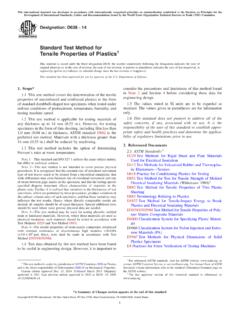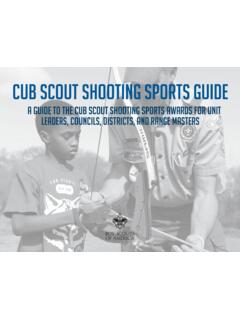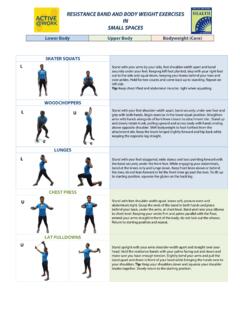Transcription of Army Combat Fitness Test Training Guide
1 Training Aid Refer to FM 7-22 for expanded Training programs and additional exercises 1 Army Combat Fitness Test Training Guide INTRODUCTIONThe purpose of the Army Combat Fitness Test (ACFT) Training Guide is to provide exercises that will help Soldiers successfully prepare to take the ACFT. These specific exercises will help develop strength, endurance, and mobility using common strength Training methods and Army doctrine. The Army s current Physical Readiness Training doctrine, Field Manual 7-22 (October 2012), and the Army Physical Readiness Training application for smart devices (iOS and Android) can assist with more extensive workout information. Refer to Preparation Drill (PD), Hip Stability Drill (HSD), Shoulder Stability Drill (SSD), Four for the Core (4C), and Military Movement Drills (MMDs) for warm-up exercises and Recovery Drill (RD) in FM 7-22 for cool-down exercises.
2 A copy of FM 7-22 can be found at: The exercises and drills in this Guide can be conducted anywhere and are not resource intensive. When time or environmental constraints limit PRT sessions, this Guide will provide potential modifications to individual and collective Training . 08/27/2018 Training Aid Refer to FM 7-22 for expanded Training programs and additional exercises 2 OVERVIEW Table 1: A Summary of the recommended garrison and field exercises and supporting drills for each ACFT event. Alternate equipment options are listed for circumstances where standardized Training and testing equipment is not available. 3 Repetition Maximum Deadlift Standing Power Throw Hand-Release Push-up Sprint- Drag- Carry Leg Tuck 2 Mile Run Top Exercises 1. Sumo Squat2. AlternateStaggered SquatJump3. Jump2. OverheadPush-Press3.
3 Tuck Jump1. SupineChest Press2. Straight-Leg Deadlift2. Bent OverRow3. 300 MShuttle Run1. Bent LegRaise2. Leg Tuckand Twist3. AlternatingGrip (30:60s,60:120s) HillRepeatsTop PRT Drill Strength Training Circuit Conditioning Drill 3 Four for the Core Guerilla Drill Climbing Drill 2 10 x 60:120s Standard Equipment Alternate Equipment 60lb trap bar and plates Ammo Cans Duffle Bag Rucksack 5 gallon water cans Tow bars PVC pipe Wooden handle 10lb Medicine Ball 10lb sand bag Slam ball Kettlebell Kettlebells Ammo Cans Tow bar IOTV 2x40lb KBs 90lb sled 40lb Duffle 40lb Rucksack 90lb SKEDCO 90lb Litter 90lb Log Tires Climbing Bar Pull-up bar Suspension trainer Stretch Cords 2MR Route Treadmill (to simulate the drills and exercises listed above.) Training Aid Refer to FM 7-22 for expanded Training programs and additional exercises 3 EVENT Training 3 Repetition Maximum Deadlift TOP THREE EXERCISES Exercise 1: Sumo Squat (from Strength Training Circuit (STC) Drill) Risk Mitigation: Soldiers should begin Training with an empty straight bar or PVC pipe to perfect their squat technique (see check points below).
4 A master Fitness trainer can assist in developing proper form. Beginners should work for 2-4 weeks at loads of 40-50% of their body weight (ex: body weight = 170lbs; lift weight = 70-85lbs) or 25-50% of their 1 repetition maximum (1RM). Beginners should maintain a relatively constant weight and increase repetitions with proper technique during a 2-4 week base phase. Purpose: This exercise develops strength, endurance and mobility of the trunk and lower extremities. Equipment: Kettlebell, straight bar (45lbs), weight plates, collars, spotter. Starting Position: Straddle stance with the feet wider than the shoulders and the toes pointing outward. Hold a single kettlebell or straight bar with both hands, in front of the body, using a pronated grip (palms facing the body). Weight will be appropriate for the goal of the PRT session.
5 Training Aid Refer to FM 7-22 for expanded Training programs and additional exercises 4 Execution: Squat while leaning slightly forward from the waist with head in line with the spine. Move downward until the upper legs are at least parallel to the ground, pause and return to the starting position. Exercise Prescription: 2-3 Sets of 12-15 reps using weight equal to 50-65% of 1RM. Figure 1: Sumo Squat Check Points: Ensure feet are spread wider than shoulder width apart. Ensure knees are in line with the toes and heels remain on the floor. Ensure head and neck are in line with eyes facing forward. Avoid rounding of the shoulders and spine and avoid letting the knees collapse inward(knock-knee). Training Aid Refer to FM 7-22 for expanded Training programs and additional exercises 5 Exercise 2: Alternate Staggered Squat Jump (from Conditioning Drill 3 (CD3))Risk Mitigation: Soldiers will perform a dynamic warm-up before starting this exercise.
6 A master Fitness trainer can assist in developing proper form. Beginners should start with 5 repetitions in a limited range of movement. Beginners should increase repetitions with proper technique to 10 repetitions across a 2-4 week base phase. Purpose: This exercise develops balance and explosive strength of the legs. Equipment: Level space. Starting Position: Staggered stance with the left leg back and arms at sides; the trunk is generally straight, but tilted slightly forward. Execution: Squat and touch the ground between the legs with the fingertips of the left hand. Jump forcefully into the air, switching legs in mid-air to land with the right leg back and arms at the sides. Repeat the squat, touch and jump on the opposite side. Exercise Prescription: 1 Set of 5 to 10 repetitions. Figure 2: Alternate Staggered Squat Jump Check Points: Do not allow the back to round; keep the head up and the eyes forward.
7 Cadence is slow to allow for precision and adequate time to properly jump and land;however, each jump should be performed quickly and explosively. On each landing, the feet should be oriented to the front. The landing should be soft and proceed from the balls of the feet to the Aid Refer to FM 7-22 for expanded Training programs and additional exercises 6 Exercise 3: Forward Lunge (from Preparation Drill (PD)) Risk Mitigation: Soldiers will perform a dynamic warm-up before starting this exercise. A master Fitness trainer can assist in developing proper form. Beginners should start with 5 repetitions in a limited range of movement. Beginners should increase repetitions with proper technique to 10 repetitions across a 2-4 week base phase. Purpose: This exercise develops strength, endurance, balance and mobility of the legs and trunk.
8 Equipment: Level space. Starting Position: Staggered stance. Execution: Step forward with the left leg as in the forward lunge as in the PD, allowing the left knee to bend until the left thigh is parallel to the ground. Return to the starting position. Repeat with the right leg. Return to the starting position. As skill improves and to add load , perform the same movements with weight in each hand. More advanced Soldiers can increase exercise overload by adding kettlebells, water cans, sandbags, etc. to the Forward Lunge. Loads should progress from light (5lbs) to moderate (10lbs) to heavy (20lbs) in each hand. Lean slightly forward from the waist and bring the kettlebells to the left and right sides of the forward leg. Return to the starting position. Repeat with the right leg. Return to the starting position.
9 Exercise Prescription: 1 to 3 sets of 5-10 reps. Training Aid Refer to FM 7-22 for expanded Training programs and additional exercises 7 Figure 3: Forward Lunge Check Points: Keep the forward heel flat on the ground and the rear heel up. Keep the forward knee directly over the ball of the foot. Push off vigorously with the forward leg to return to the starting position. Do not allow the forward knee to go beyond the forward toes or waiver from side to not jerk the trunk rearward to return to the starting position. Ensure feet are spread approximately shoulder width apart. Ensure knees are in line with the toes and heels remain on the floor. Ensure head and neck are in a neutral position with eyes facing forward. Avoid rounding of the spine and letting the knees collapse inward (knock-knee). Training Aid Refer to FM 7-22 for expanded Training programs and additional exercises 8 EVENT Training Standing Power ThrowTOP THREE EXERCISES Exercise 1: Power Jump (from Conditioning Drill 1 (CD1)) Risk Mitigation: Soldiers will perform a dynamic warm-up before starting this exercise.
10 A master Fitness trainer can assist in developing proper form. Beginners should start with 5 repetitions in a limited range of movement. Beginners should increase repetitions with proper technique to 10 repetitions across a 2-4 week base phase. Purpose: This exercise develops balance and explosive strength of the legs. Equipment: Level space. Starting Position: Straddle stance with hands on hips. Execution: Squat with the heels flat, bending forward at the hips and keeping the back straight to allow the straight arms to reach to the ground. Attempt to touch the ground with the palms of the hands. Jump forcefully in the air, vigorously raising arms overhead, with palms facing inward. Control the landing and then repeat the squat and jump movement. Exercise Prescription: 1 Set of 5 to 10 repetitions. Training Aid Refer to FM 7-22 for expanded Training programs and additional exercises 9 Figure 4: Power Jump Check Points: Keep the back straight to assist with generating power.



















